Updated: January 31, 2025
Written by Adam Graham
Cristina has more than 4 years of experience in the remodeling and home design sector. She joined Fixr.com in 2017 and has since been working constantly with industry experts to bring the most accurate and reliable information regarding news, trends, and advice to homeowners and other industry pros. Her work has appeared in major industry publications, like Forbes, Realtor.com and the official publication of the National Kitchen & Bathroom Association.
Learn moreReviewed by Cristina Miguelez
Fireplaces make a wonderful addition to any home. They increase a home’s value, add to the decor of a room, and even function as a supplemental heating source. Many options are available to choose from, including fuel sources, shape, mounting, and design, allowing you to customize your fireplace’s appearance.
The cost of your fireplace depends on the fuel source you choose, the material for the mantle, the style, and the placement. But on average, homeowners pay between $3,000 and $20,000 to have a fireplace installed. Most pay around $15,000 for a wood-burning fireplace with a tile surround and a tempered glass door, with a new chimney and flue in an existing home. Costs run from as low as $700 for an ethanol, freestanding fireplace with no mantle or surround to as high as $30,000 for a masonry, wood-burning fireplace with a granite surround and hearth, and ceramic glass door, along with a three flue chimney in an existing home.
Fireplace Installation Cost
| Fireplace Costs | |
| National average cost | $15,000 |
| Average range | $3,000-$20,000 |
| Low-end | $700 |
| High-end | $30,000 |
New Fireplace by Type of Installation
The cost of installing a fireplace varies depending on whether you install it in an already existing home or have one added in a new construction. The cost range is vast, primarily because different types of fireplace installations require less labor and ancillary costs while others take a lot of additional time and materials. Below you will see the average price range for installing a new unit in an existing home versus installing one in a new construction. High cost ranges include the cost of a new chimney and flue in addition to the fireplace itself. Low costs are for prefab electric fireplaces that do not require significant changes to the home for installation.


| Installation Type | Price Range (Installed) |
| New Construction | $1,600 - $10,000 |
| Existing Home | $1,600 - $40,000 |
Fireplace Cost New Construction
The costs to add a fireplace to a home currently being constructed are between $1,600 and $10,000. Costs vary depending on the type you are installing. Electric prefab units cost considerably less to install than a large, masonry wood-burning unit that requires a chimney and flue. The type, how it will be fueled, and where in the home it will be installed can all impact the cost of the project. Custom installations with built-in cabinetry or surrounds can also increase the cost. The more changes that must be made to the surrounding area to install the unit, the higher the total costs will ultimately be.
Adding a Fireplace to an Existing Home
Installing a fireplace in an existing home costs between $1,600 and $40,000. The cost for your installation primarily depends on the type you are installing and the location. Small electric units will be the least costly, while masonry models added to homes without existing chimneys will be the most expensive. Costs can also vary by the location of the new unit. If you need to build new walls or remove existing walls to add the fireplace, your costs will be higher.
Masonry vs Prefabricated Fireplace Cost
There are two basic ways to create a fireplace, using a prefab unit or building a custom or masonry unit. This can be further broken down by the type of fireplace you are installing. All gas and electric units are technically prefabricated. They can be given custom installations, however, to change their finished appearance and make them appear more built into the home.
Wood-burning models can be created in two different ways. They can have a prefab fireplace that may be constructed of metal or some type of prefabricated masonry. This unit is installed first. Then, a finished surround is put around it.
A masonry fireplace is different. This is built right inside your home, typically using either brick, masonry blocks, or another type of fireproof material. Masonry fireplaces can take on many different sizes, shapes, and styles that you won’t necessarily see with a prefabricated fireplace.
Both masonry and prefab wood-burning fireplaces must be given a finished exterior. Gas and electric units only need a finished exterior if using a custom installation; otherwise, the prefab model has everything necessary for the project. The costs below are for the total average costs installed for both prefab and custom units, not including the cost of a chimney or flue.


| Type | Average Prices (Installed) |
| Prefab | $1,550 - $10,000 |
| Custom/Masonry | $2,500 - $22,000 |
Prefab Fireplace
The cost of a prefab fireplace ranges from $1,550 to $10,000 installed. These costs include the costs of electric, gas, and wood-burning units. The costs for electric and gas include the cost of the unit and a basic wall or insert installation with hookup and are reflected in the lower end of the cost range. The costs for a wood-burning fireplace include the prefab unit, its installation, and basic finish work, not including the unit surround, mantel, or hearth. These costs reflect the high end of the range. All prefab units come in a range of sizes. However, you may be more limited in shape and size than with a custom build.
Custom Fireplace
The cost of a custom fireplace installation is $2,500 to $22,000. These costs include the costs of electric, gas, and wood-burning units. The costs for electric and gas include the cost of the unit and a custom installation. Custom installations include building a new wall or creating a built-in unit such as an entertainment center, corner, or island installation. Custom installations for wood-burning units include the masonry construction of the firebox and the surrounding area. Electric and gas fireplace installations are on the lower end of the total range. Wood-burning custom installations are at the high end of the range.
Fireplace Cost by Fuel Source
One of the primary factors determining the cost of your fireplace installation is the type of fuel that runs your unit. Your fuel source dictates what type of unit you can use and whether or not the unit needs venting or a chimney. Below are the types of fuel sources you can choose from and the cost range for material only.

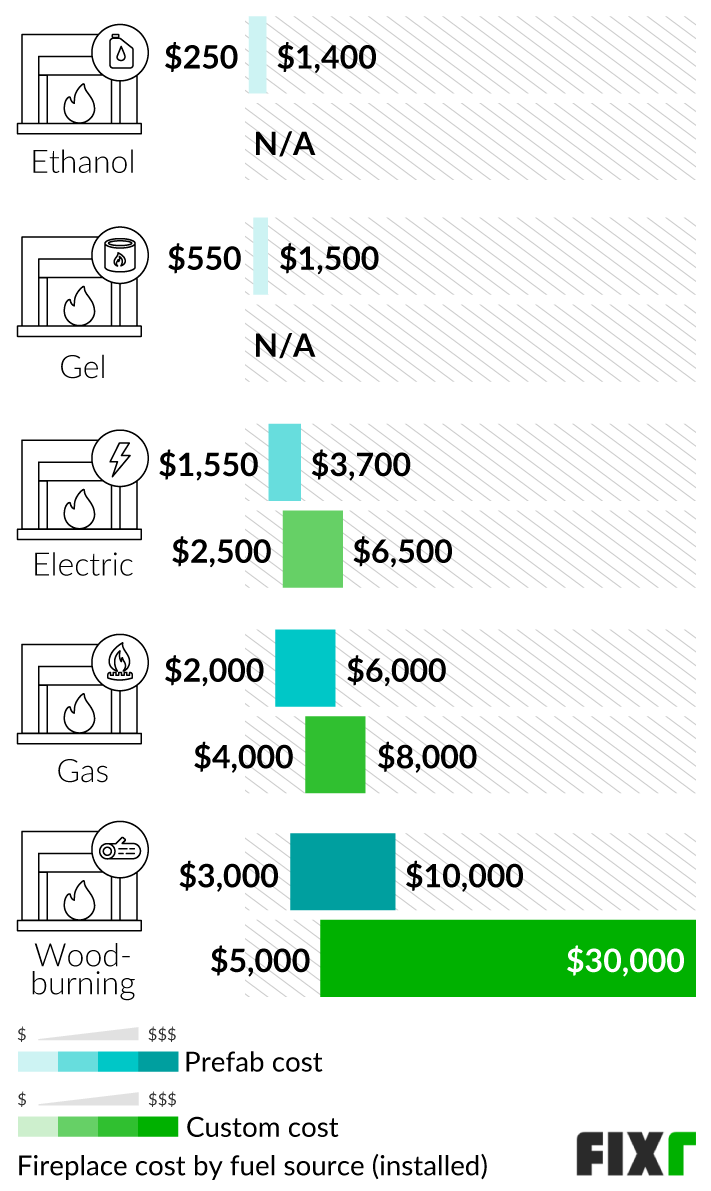
| Type | Prefab Prices (Installed) | Custom Prices (Installed) |
| Ethanol | $250 - $1,400 | N/A |
| Gel | $550 - $1,500 | N/A |
| Electric | $1,550 - $3,700 | $2,500 - $6,500 |
| Gas | $2,000 - $6,000 | $4,000 - $8,000 |
| Wood-Burning | $3,000 - $10,000 | $5,000 - $30,000 |
Ethanol Fireplace
You can expect to pay from $250 up to $1,400 for an ethanol fireplace, with usually does not require professional installation. They come as tabletop models, wall-mounted units, freestanding, or recessed. You can convert an old unit to ethanol by adding an ethanol burner. They are extremely simple to use and do not require any venting or chimney to be installed. They just need to be filled with ethanol and kept clean to function properly.
Gel Fireplace
The cost of a gel fireplace is from $550 up to $1,500. They are ventless and require minimal to no professional installation. Once set up, the logs simply need to be placed in position. You can choose from wall-mounted or freestanding models. These can even be used in apartments. One can of fuel provides an average of two hours of use. While they do not heat like a gas or wood-burning unit, they still provide warmth in smaller rooms.
Electric Fireplace
The costs of an electric fireplace range from $1,550 to $3,700 for a prefab unit and installation. Units with custom installation cost between $2,500 and $6,500. Electric units come in several styles, from freestanding and three-sided models to wall-mounted and built-in. While electric units help heat a room, they also improve the ambiance and create a modern and sophisticated look in any room. They create no emissions, meaning they do not require venting or a chimney to operate safely. They require a dedicated circuit to run on, and in some cases, may require a panel upgrade, which can increase costs.
Gas Fireplace
A gas fireplace runs from $2,000 to $6,000 for a prefab unit and installation. The cost of a unit with custom installation is $4,000 to $8,000. They are often found in colder climates because they can be used as an additional heating source. These units will typically have fake logs to give the impression of a wood fire and use a pilot light to light the gas and start up. They may also have a hearth, a firebox, a facade or facing, usually glass, and often a decorative liner.
Since these units produce emissions, most of them require both a vent and a chimney for the emissions to leave the house. Ventless options are available. However, they are not recommended for those who are sensitive to smells since small amounts of fumes will be released in the home. This type of system is illegal in some states and is strictly regulated in others. Always check with your installer to find out if this is a good fit for your home.
Wood-Burning Fireplace
The cost of a wood-burning fireplace installation is $3,000 to $10,000 for a prefab unit. A custom or masonry unit is $5,000 to $30,000, depending on material, size, and style. Wood-burning fireplaces are popular for more traditional homes, cabins, and those who want the smell and sound of real, wood-burning flames. Wood-burning unis provide a lot of heat and, in the case of cabins, may be the primary heating source. Since a wood-burning unit emits smoke, you need to have the fireplace vent through a chimney.
Wood-burning units consist of an outer and inner hearth and fire brick along the back. They also have a holder for wood to be placed on and an ash dump below. Above the unit is a damper that can be opened and closed. The damper needs to be opened when the fireplace is on so that the smoke exits through the smoke chamber and out of the chimney.
Fireplace Installation Cost by Type
The type of mounting you choose affects the price of your fireplace. Freestanding models have minimal installation costs, while models set in a wall cost more. Even though the cost of installing different types varies, cost should not be the only factor in making your decision. Different types of mountings are better suited for different areas, types of homes, and types of decor. Below you will see the cost range to install a fireplace based on its mounting type.

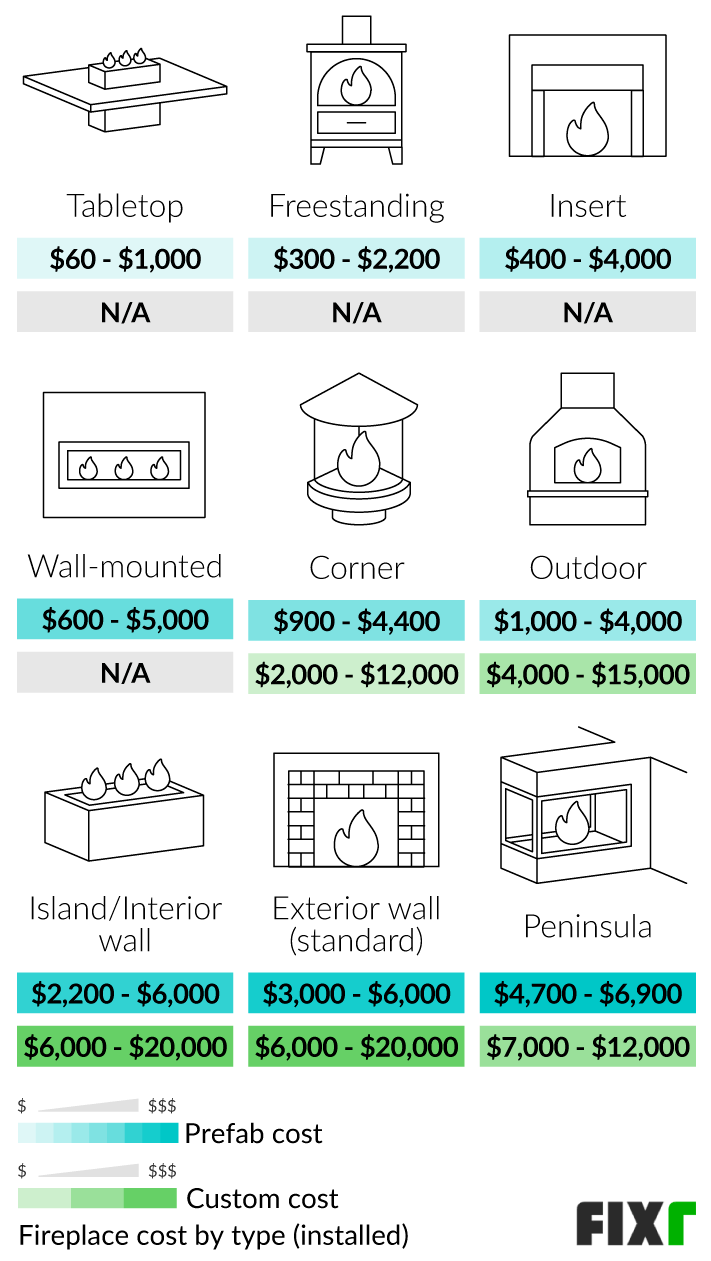
| Type | Prefab Cost Range (Installed) | Custom Cost Range (Installed) |
| Tabletop | $60 - $1,000 | N/A |
| Freestanding | $300 - $2,200 | N/A |
| Insert | $400 - $4,000 | N/A |
| Hanging/Wall-Mounted | $600 - $5,000 | N/A |
| Corner | $900 - $4,400 | $2,000 - $12,000 |
| Outdoor | $1,000 - $4,000 | $4,000 - $15,000 |
| Island/Interior Wall | $2,200 - $6,000 | $6,000 - $20,000 |
| Exterior Wall (Standard) | $3,000 - $6,000 | $6,000 - $20,000 |
| Peninsula | $4,700 - $6,900 | $7,000 - $12,000 |
Tabletop Fireplace
You can expect to pay from $60 to $1,000 for a tabletop unit. They do not have any installation fees. These types come ready to use straight out of the box and require minimal assembly. They come in various options, designs, and colors and make a great addition to any decor. They can be gas, electric, gel, or ethanol-based. Most can be used both indoors and outdoors, but always check usage and safety considerations for each one.
Freestanding Fireplace
The cost of a freestanding unit is $300 to $2,000 on average. These are one of the least expensive types to purchase and install. Freestanding units also do not require any installation. Depending on the type, they can be powered by ethanol, gel, electricity, or natural gas and propane. They are designed to be either plugged into the wall or connected to their own small fuel supply. They do not require any professional installation. They are not considered to be a permanent addition to your home.
Fireplace Insert Installation
The average cost to install a fireplace insert runs from $400 to $4,000. They are easy to install but should be done by a professional. They are designed to turn your existing wood-burning unit into an electric or gas fireplace. They may require some minor adjustments to the existing firebox. Electric units require some electrical wiring, while gas units require a gas line. Depending on the size and position of the unit, your costs may be higher if the line must be run from a distance or if the insert requires an electrical circuit upgrade.
Hanging Fireplace
Installing a hanging or wall-mounted fireplace on a flat wall costs from $600 to $5,000. A wall-mounted or hanging unit can be found in both electric and natural gas-powered models. These are very contemporary options for installing a fireplace in your home. They are minimalist in design and are made to either hang on the wall or be installed inside and flush to the wall. Because of their weight, they require some support and professional installation. If you choose to modify the wall for the installation, this increases the cost of the project.
Corner
It can cost from $900 to $4,400 to have a prefab corner fireplace installed. A custom install can cost $2,000 to $12,000. This type of mount is often used when space is minimal, such as in an apartment or small room. There are several different ways to create a corner unit. Some electric and gas fireplaces have prefab corner models that only need minor setup and installation. It is also possible to use an electric or gas unit in the corner with a custom setup and build. If you choose, you can also have a wood-burning fireplace built into the corner, although this can have more complicated setups due to the need for space. Expect the corner setup to take up more room in a wood-burning installation than in an electric or gas setup.
Build Outdoor Fireplace
An outdoor unit costs from $1,000 to $4,000 for a prefab unit. The cost of a custom install is $4,000 to $15,000. The reason for the wide range is that outdoor fireplaces can be as simple as plugging in an electrical unit to as complicated as building an outdoor hearth, surround, and mantle to house a wood-burning fireplace. You can also have a gas unit installed with a brick or masonry surround and a gas line extended to the area. Outdoor models transform outdoor spaces into living areas and are ideal for entertaining and keeping you warm in chilly weather. Outdoor units can be one-sided, two-sided, or three-sided, depending on the type and setup. Keep in mind that wood-burning fireplaces also need some type of chimney to help direct the smoke away from those sitting nearby.
Interior Wall or Island Fireplace
If you want an island or interior wall unit installed in your home, you can expect to pay $2,200 to $6,000 for a prefab unit. The cost of a custom unit is $6,000 to $20,000. These are often chosen for aesthetic reasons or an additional heating source in a large open space. They work best in large rooms. One of the most popular types is a see-through model, which looks like an open fireplace in the middle of the room. They are often larger models, making them more expensive. These units can be constructed in a few ways. Using an electric model, you may build a new wall to house it or simply create a small island with a top. Gas models can be installed the same way, but if you vent through an interior location, you need the full wall to conceal the vent pipes. Wood-burning installations installed in this way require a full chimney, which may be concealed inside the wall.
Adding a Fireplace to an Exterior Wall
You can expect to pay $3,000 to $6,000 for a prefab unit to install a fireplace on an exterior wall. The cost of a custom installation is $6,000 to $20,000. The most common reason to install a fireplace on an exterior wall is to vent the unit outdoors. This is necessary for many types of gas and wood-burning models. The unit itself can be built by bumping out the exterior wall, creating a chimney around the bump out, or building into the room itself. In some cases where space is at a premium, both of these methods may be combined. Remember that you will need to have some type of chimney built in this installation, which increases costs, depending on the type you choose.
Peninsula
Building a peninsula fireplace is $4,700 to $6,800 for a prefab unit installation. The cost of a custom installation is $7,000 to $12,000. They are most commonly gas models, although it may be possible to build one around an electric unit as well. Peninsula fireplaces extend outward from a wall into the room. The unit itself may be two- or three-sided, allowing you to see the flames as you walk around it. If you use a gas model, it will usually either be ventless or vent out the side of the peninsula through an exterior wall. This type of installation is almost always custom, although there are a few prefab models available for this type of setup.
Labor Cost to Install a Fireplace
Depending on the type of fireplace you plan to install, you could pay more for labor than the actual costs of materials. In general, gas and wood-burning units are the most expensive to install when it comes to labor. The increased cost is because they require a venting system installed with them to help keep them safe. Below you will see the costs for labor based on the fuel type. These costs include the installation of the unit only. They do not include the construction of a chimney, which can increase costs. Keep in mind that custom installations cost more than prefab models that are simply hung on a wall or placed as an insert. A custom build requires additional materials and labor, making the total cost range much higher than installing a prefab unit on its own.
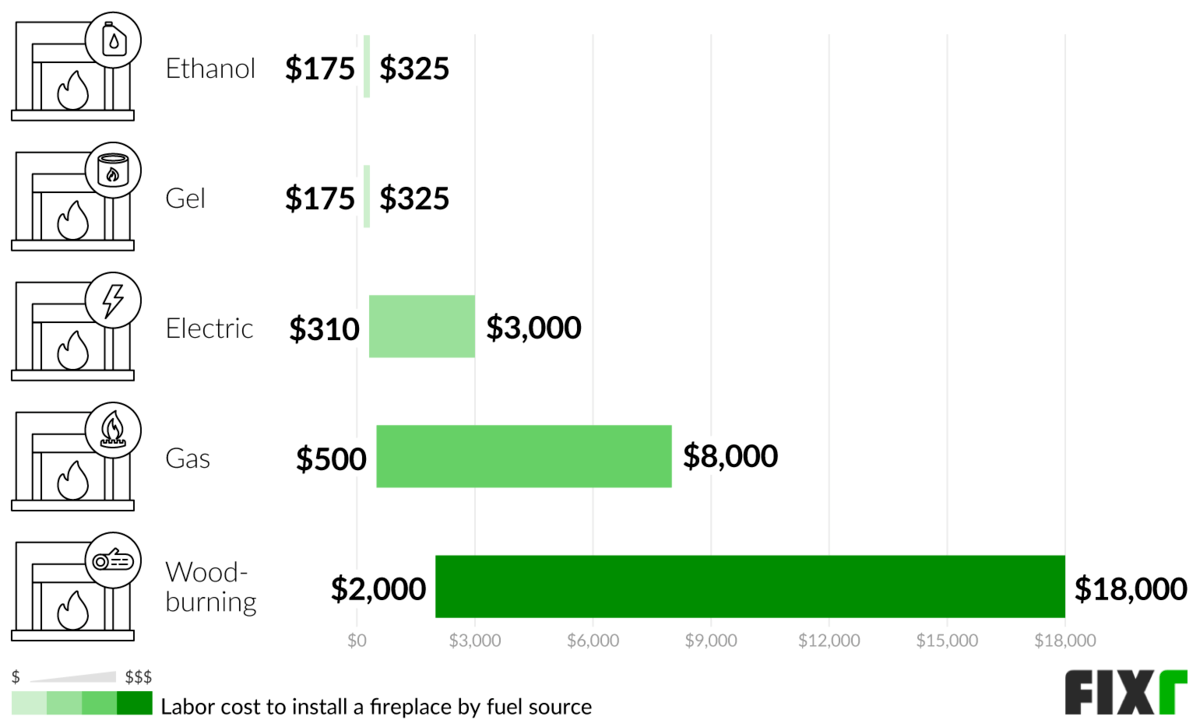
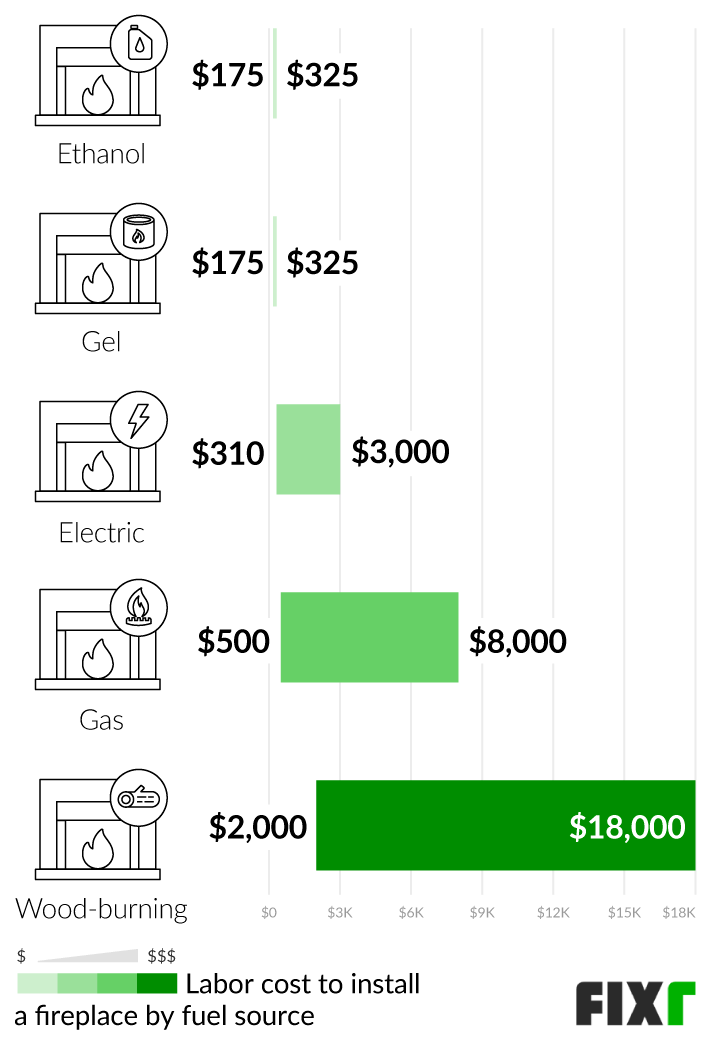
| Type | Labor Costs |
| Ethanol | $175 - $325 |
| Gel | $175 - $325 |
| Electric | $310 - $3,000 |
| Gas | $500 - $8,000 |
| Wood-Burning | $2,000 - $18,000 |
Ethanol Fireplace Installation
Installing a prefabricated ethanol unit costs from $175 to $325 for the labor. Most of them don’t require any professional setup or installation. This includes freestanding and tabletop models. However, if you choose to have the unit wall-mounted or recessed into a wall, you will have additional labor costs. Simple wall hanging is the least expensive method of installing this type of unit. Opening a wall can include some minor carpentry work, which increases costs.
Gel Fireplace Installation
The cost to install gel fireplaces goes from $175 to $325 for labor. They are very similar to ethanol units in terms of installation. Many are designed for freestanding or tabletop use. These do not require any professional installation. However, if you wish to have one wall-mounted or recessed into the wall, you will have additional costs. Opening the wall will have slightly higher costs due to the carpentry involved versus simply hanging the unit on the exterior of the wall.
Electric Fireplace Installation
Electric units are relatively easy to install and cost between $310 and $3,000 in labor to complete the work. While some electric models can be plugged in with no additional electric work, some require additional wiring to operate. Your installation costs will be higher on average if you choose to wire the unit directly to your home’s electrical system. Likewise, costs may be higher if you choose to have a custom installation or need a circuit panel upgraded to support the unit. Some wall-mounted units may only require mounting fees if a nearby plug is on a dedicated circuit. Otherwise, you will pay for both mounting and either a new outlet or for the unit to be hardwired.
Install a Gas Fireplace
The cost to install a gas fireplace ranges from $500 to $8,000 for the labor. There are many different ways to install a gas unit. They can be vented to the outdoors or ventless. They can be installed in a wall, in an existing fireplace, or given their own, custom build. To operate properly, they must have a gas line run to the area. Depending on how far this line is going, it can potentially increase costs by an additional $500 to $2,000.
Add a Wood-Burning Fireplace
The labor cost of the installation of a wood-burning fireplace is $2,000 to $18,000. They usually have the highest installation costs both for material and labor. This is due to the way that the system must be installed. Even prefabricated units need to be fully lined, framed in, and given a finished surrounding. Custom or masonry units are built by hand using bricks or fire-blocks and mortar. They are then lined and framed in like the prefab units. Costs vary depending on whether or not the unit will be installed on an outside wall or in the center of the home. Adding a wood-burning unit to an existing home can also have higher costs than adding it during new home construction.
Cost to Build a Fireplace Surround by Material
The material that your fireplace surround is made of largely determines the look of your unit. Various materials can be used to create your surround, such as tile, wood, stone, brick, and concrete. While these are all options, the surrounds that require the most labor and particulars to install are tile, brick, and stone. Below you can see the costs to install each of these materials.
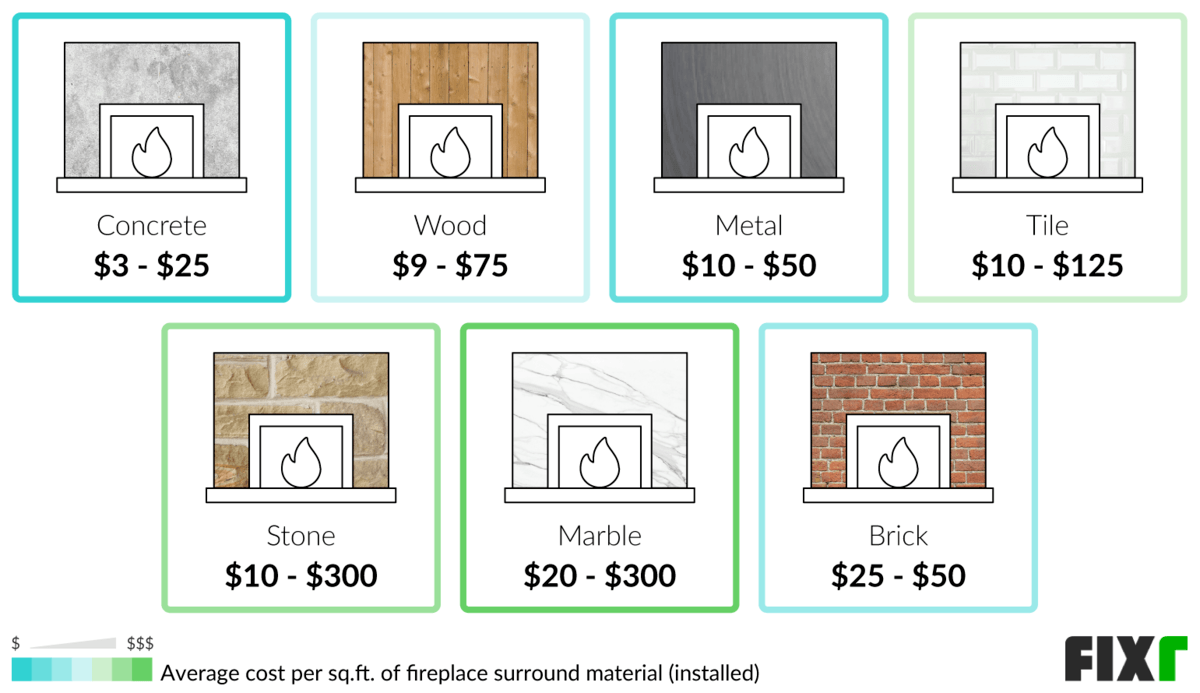

| Material | Average Costs per Sq.Ft. (Installed) |
| Concrete | $3 - $25 |
| Wood | $9 - $75 |
| Metal | $10 - $50 |
| Tile | $10 - $125 |
| Stone | $10 - $300 |
| Marble | $20 - $300 |
| Brick | $25 - $50 |
Concrete Fireplace Surround
Concrete surrounds can cost between $3 to $25 a sq.ft. There are several different ways to create a concrete surround. Basic, poured concrete is the least expensive method. You can dye the concrete or add some texture to it to help give the surround a different look. Stamping the concrete, adding different surface textures or colors that can give it the look of stone increases the costs. Concrete can be used to give your fireplace surround the look of fieldstone at a lower cost.
Wood Fireplace Surround
The cost of a wood fireplace surround ranges from $9 to $75 a sq.ft. There are several different options for wood surrounds as well. Wood surrounds can be made out of single pieces of carved wood with a mantel attached. Or, they can be made up of multiple pieces of reclaimed wood pieced together for a rustic look. The reason for the wide range is that different wood types have different costs. Pine is typically your cheapest option, while harder woods like walnut will be the most expensive. Wood is also a good option if you are looking to match natural wood trim in a room.
Metal Fireplace Surround
The cost of a custom metal surround for a fireplace is $10 to $50 a sq.ft. Many gas and electric units come with a minimal metal surround. When installed in the wall, the metal is flush with the wall itself, giving the unit a modern appearance. It is also possible to get a custom metal surround made for any type of model. This can be made of any metal from copper to stainless steel. The one exception to this is aluminum. Aluminum has a low melting point, which means that it may warp if used beside a fireplace.
Tile Fireplace Surround
The cost of a tile surround ranges from $10 to $125 a sq.ft. Many different types of tile can be used for a fireplace surround. Tiles come in an incredible range of color, size, shape, and style. This includes glass tiles, ceramic tiles, and stone tiles. Using tile for your unit surround gives you many different options for customization. You can easily match the style of your home and your home’s architecture using tile to complete the surround.
Build a Stone Fireplace Surround
The cost of a stone surround ranges from $10 to $300 a sq.ft. There are many different ways to create a stone surround for your fireplace. You can use single, large pieces of stone carved into both a surround and mantel. You can also use stone tiles, stacked stone, stone veneer, or fieldstone to create your surround. Stones for surrounds may be made of marble, granite, limestone, travertine, or slate. Each one comes in a range of different colors and options to help you find a stone surround that fits your decor.
Marble Fireplace Surround
The cost of a marble surround ranges from $20 to $300 a sq.ft. Marble surrounds can be created in several ways. You can use large blocks of stone carved into a single piece for both the surround and mantel. You can also use a variety of different marble tiles to create the surround as well. Marble comes in several different colors and finishes. Polished marble gives you an elegant look, while tumbled and antiqued marble gives you a more rustic appearance.
Brick Fireplace
The cost to install a brick surround on a fireplace is $25 to $50 a sq.ft. There are two ways to build a brick surround. The first is to use masonry techniques to build the area around the firebox using bricks and mortar. This is the most expensive method and requires a new wall to be built. The second method uses brick veneers and goes over the surface of an existing wall like tile. This is a good option for creating a surround for a gas or electric fireplace to give it the look of a wood-burning fireplace.
Fireplace Hearth Cost by Material
Your fireplace hearth is an important part of the aesthetics and safety of your unit. The hearth is the floor area in front of the unit made of material that is non-combustible and resistant to heat. Materials can be made of a wide range of non-combustible materials, including brick, stone, and tile. If you have brick or stone on the exterior of your fireplace, the hearth will likely be made of similar materials, but this is not necessary. If desired, you can create a hearth in a different color, style, or pattern to add depth and dimension to the room.
Hearths are typically needed for wood-burning fireplaces to help contain the fire and emission and protect the surrounding walls. Electric, gel, gas, and ethanol units do not require hearths. Below you can see the common materials used for hearths and the cost range for materials.


| Material | Price Range per Sq.Ft. (Installed) |
| Concrete | $3 - $25 |
| Sandstone | $10 - $25 |
| Tile | $10 - $125 |
| Slate | $10 - $200 |
| Granite | $10 - $300 |
| Bluestone | $20 - $30 |
| Limestone | $20 - $200 |
| Marble | $20 - $300 |
| Brick | $25 - $50 |
Concrete Hearth
The cost of a concrete hearth ranges from $3 to $25 a sq.ft. There are many ways to create a concrete hearth. You can make a single slab of concrete for a minimalist appearance. You can also create a slab with a rustic edge to it. If you choose, you can also use stamps and pigments to make the concrete appear to be another material such as stone at a lower cost. Concrete slabs are generally low maintenance, but you may want to seal them if using with a wood-burning fireplace to avoid stains.
Sandstone Hearth
The cost of a sandstone hearth generally ranges from $10 to $25 a sq.ft. Sandstone is a popular sedimentary rock that can be used for a fireplace hearth and is often paired with a stone surround. Sandstone is composed mostly of quartz sand, giving it a sparkling appearance when the light hits it. Sandstone comes in colors ranging from beige to brown and works well when a neutral accent is needed. Sandstone is available in tiles, as well as individual pieces of stone. Sandstone is fairly durable, but chips if hit hard. If you use sandstone with a wood-burning fireplace, it should be sealed to prevent staining.
Tiled Hearth
The cost to install a tile hearth can range from $10 to $125 a sq.ft. depending on the tile used. Any type of tile can be used on a hearth, including many types typically only used on the walls. Because the hearth doesn’t tend to get a lot of foot traffic, even more fragile types of tile can easily be used in this area. All types of tile can be used to create a unique and long-lasting hearth. You can choose to match the surround or contrast it for depth. You can also choose tiles in a range of different colors and patterns to match your overall decor.
Slate Hearth
The cost of a slate hearth ranges from $10 to $200 a sq.ft. Slate is available in both tiles and slabs. Slate is a metamorphic stone made from sandstone. It can be quarried all over the world and comes in a brilliant range of different colors. While Vermont slate is a rich, blue-gray color, slate from Brazil, China, and India range from red and gold to deep purple and green. Slate can be polished, matte, or given a natural cleft finish. Slate will be very dusty for the first few months after its installation, and ungauged, cleft finishes may have tiny pieces break off during this time. This is normal and is just the material getting used to its new home.
Granite Hearth
The cost of a granite hearth ranges from $10 to $300 a sq.ft. Granite is an igneous rock that comes in an incredible range of colors and styles. Granite can be found in both tile and slabs. A tiled granite hearth costs considerably less than a slab granite hearth. Granite can be polished, honed, and in some cases flamed or leathered for texture. Granite hearths are incredibly durable and long lasting. The darker colors require little to no maintenance beyond cleaning. Lighter colors may need to be sealed to help protect them from stains if used with a wood-burning fireplace.
Bluestone Hearth
The cost of a bluestone hearth runs from $20 to $30 a sq.ft. Bluestone is a sedimentary rock like limestone but is formed from deposits in rivers, oceans, and other bodies of water, giving it even layers and grains. The stone has a moderate texture which adds to its appearance and unique array of blue/gray colors. Bluestone is usually installed in large tiles. Depending on the size and shape of the tiles and the size of your hearth, it may be installed in a pattern. Bluestone makes a beautiful addition to many types of fireplaces, including those that have a brick surround.
Limestone Hearth
The cost of a limestone hearth is between $20 and $200 a sq.ft. installed. Limestone is a sedimentary rock that provides a unique, muted look. It’s available in both tiles and slabs of several colors and styles. Many types of limestone are embedded with small fossils of snails, shells, and other sea creatures that were in the area when the stone was formed. It works well in both traditional and more modern designs and fits in well with various colors. Limestone comes in different textures depending on where it was quarried. French limestone tends to appear more rustic in style than other types.
Marble Hearth
Materials for a marble hearth run from $20 to $300 installed. Marble hearths can be unique due to the various types of veining, which can change the whole color of the pieces. The various options and thicknesses to choose from create a wide range of possible costs and allow homeowners to customize the fireplace look. Marble is a popular choice in modern decor. It can be found in tiles or slabs and may be polished, honed, or antiqued in texture. Marble should always be sealed to help prevent staining.
Brick Hearth
The cost of a brick hearth ranges from $25 to $50 a sq.ft. installed. One of the most common materials used for fireplace hearths is brick, especially if the surround is brick. Brick units are great with contemporary decor and more rustic design motifs. Brick is one of the most durable options for a hearth and is designed to last decades. Brick lasts longer if you ensure that the mortar is maintained and holes are filled as needed. Brick can be found in full-thickness bricks and veneers, which can be installed much like tile.
Cost to Install Fireplace and Chimney
If you choose to install a wood-burning fireplace and do not currently have a chimney in your home, you need to have one installed with the fireplace. Wood-burning stoves and some types of gas fireplaces also require chimneys to operate properly. Chimneys are essential to the safe operation of a wood-burning fireplace as they produce particles and emissions that can lead to health problems and unsafe living conditions if they are not properly vented out of the house. Below you can see the cost range per foot for installation you can expect when you install a chimney in addition to your unit.


| Type | Cost Range per Linear Foot (Installed) |
| Metal | $75 - $100 |
| Wood Stove | $75 - $215 |
| Freestanding Stove | $75 - $215 |
| Factory Built | $85 - $150 |
| Masonry | $120 - $240 |
Cost to Replace Fireplace
If you need to replace your current fireplace, you could have a range of costs depending on the type and how it was installed. For electric, gel, and ethanol units, most of the cost will be replacing the fireplace because there is no installation involved, or you reuse things like wall mounts. You likely will not have to rehang mounts or adjust wall cut-ins unless you choose a different sized model, so you can expect to pay between 10% to 15% less than you would with a new install.
Wood-burning fireplaces are often designed to last for 20 years or more with minimal repairs or refurbishments. But if it becomes significantly damaged, replacement may be the best option. Replacement is often not as much as a new install and is usually about 20% to 35% less. While the installer must remove the old unit, they will not have to prep the area as they would with a new install. They may salvage the hearth or surround during the process, depending on the extent of the damage.
A gas fireplace replacement could be more or less than a new install. If you move from a ventless system to a vented one, the expense will be significantly higher because you need to add some type of chimney or exhaust method. Sometimes the costs may be as much as 30% higher depending on what you choose for ventilation. Yet, if you don’t need to change the venting system, you can expect a replacement to be about 20% less than the cost of a new installation.
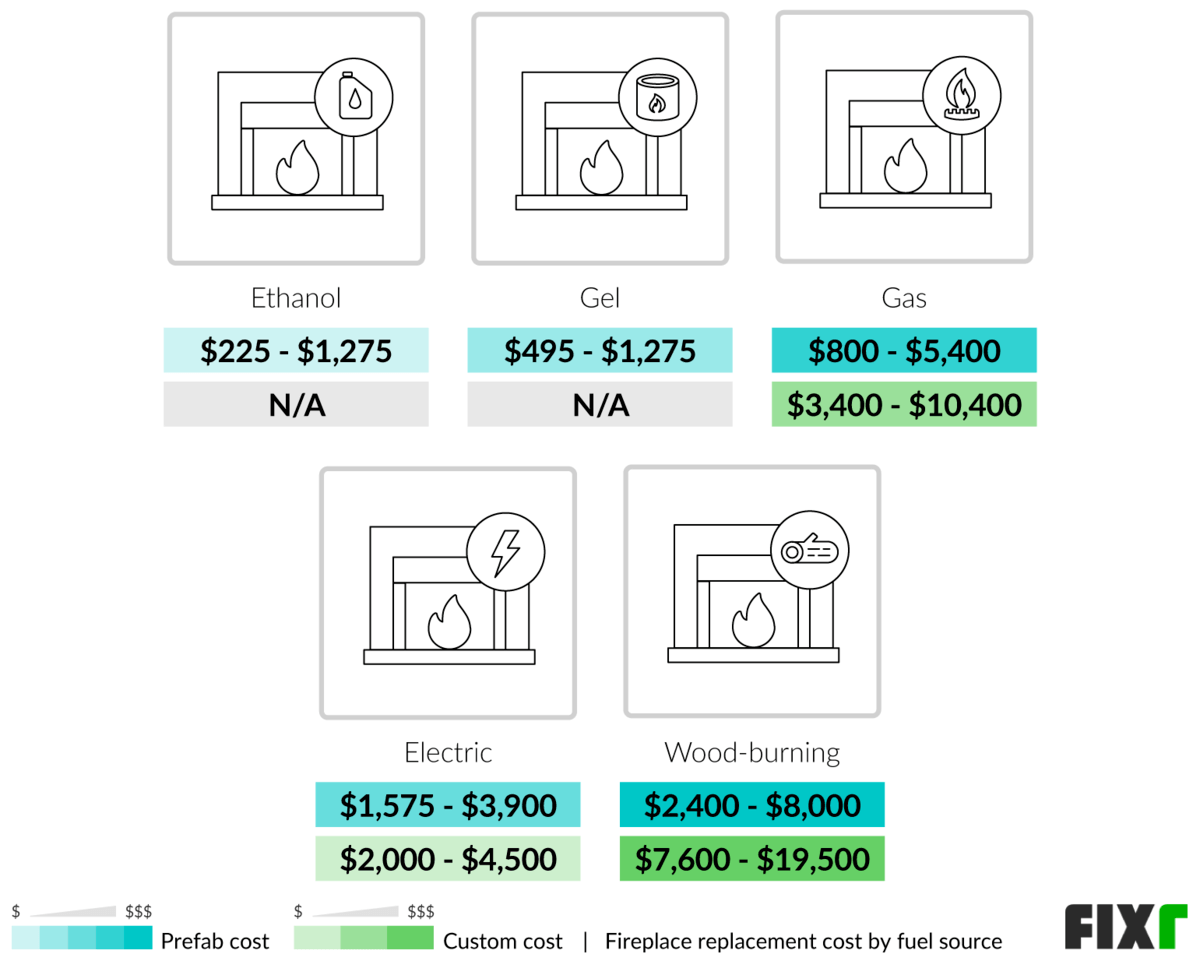

| Type | Average Replacement Costs Prefab (Installed) | Average Replacement Costs Custom (Installed) |
| Ethanol | $225 - $1,275 | N/A |
| Gel | $495 - $1,275 | N/A |
| Gas | $800 - $5,400 | $3,400 - $10,400 |
| Electric | $1,575 - $3,900 | $2,000 - $4,500 |
| Wood-Burning | $2,400 - $8,000 | $7,600 - $19,500 |
Fireplace Door Installation Cost by Type
Fireplaces are often installed with glass doors to provide greater efficiency and make the unit safer. This can be especially true with wood-burning units where embers can come out of the unit and become fire hazards. While it is advisable to have a glass door on a fireplace, it is not necessary for the unit to function. So, it will likely need to be added during your install. Below you will see the two most common glass options to choose from and the costs for each to be installed.

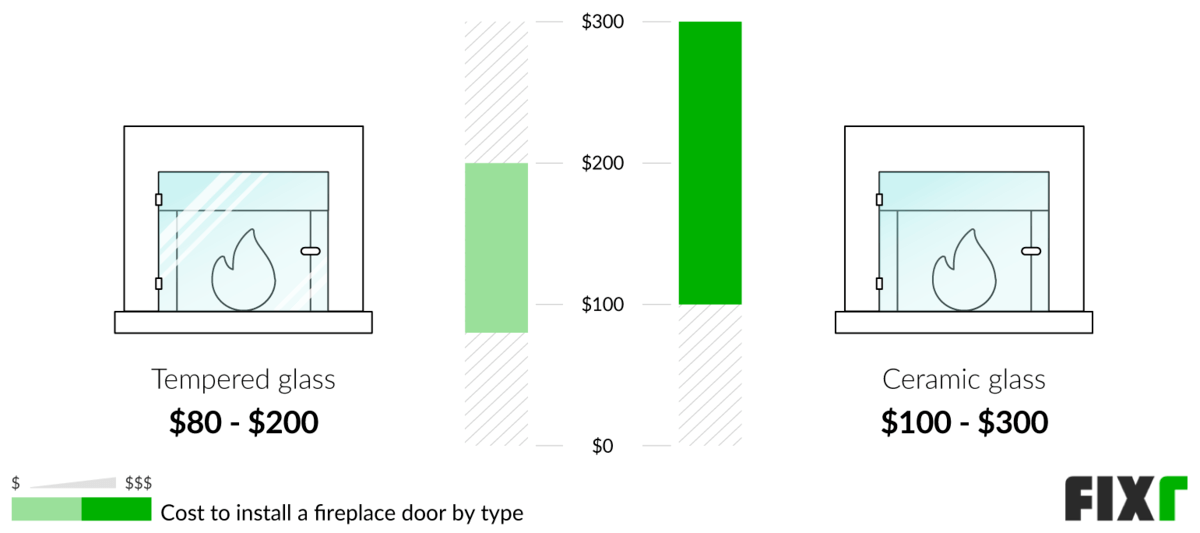
| Door Type | Average Price (Installed) |
| Tempered Glass | $80 - $200 |
| Ceramic Glass | $100 - $300 |
Tempered Glass Door
Tempered glass doors run from $80 to $200 per installed door. Tempered glass is created, through a chemical and heat process, to withstand high amounts of heat and pressure compared with regular glass, making it ideal for use in front of fireplaces. Tempered glass tends to be a more popular option with gas units when the doors are left partially open during use.
Ceramic Glass Door
Ceramic glass doors are a more expensive option and cost from $100 to $300 to have installed per door, depending on the overall size. Ceramic glass is the option most chosen with wood-burning fireplaces or when the homeowner plans to have the glass doors closed most of the time that the fire is going. Ceramic glass has lower resistance and withstands temperatures twice as high as tempered glass, making it better for constant heat.
Fireplace Screen Cost by Type
Fireplace screens can be used for adornment, to tie together the decor of a room, or to keep pets and children away from a fire, especially if you don’t have fireplace doors. Screens come in several metallic colors and finishes, which can help you easily find one to fit in with your room’s current design motif. They also have varying designs, from simplistic concepts to more ornate. Below you can see some of the most popular screens and the cost to purchase one.


| Screen Type | Cost Range (Materials Only) |
| Iron | $40 - $200 |
| Gold | $50 - $200 |
| Silver | $70 - $400 |
| Glass | $80 - $300 |
| Brass | $100 - $400 |
| Copper | $125 - $600 |
Iron Screen
You can expect to pay anywhere from $40 to $200 for an iron screen. Iron screens often have a more basic appearance and work well when you don’t want the screen to draw the eye when you walk into the room. Iron screens tend to be heavier than other options, making them a good choice if you use the screen to keep pets and children away from the fireplace.
Gold Screen
A gold fireplace screen costs between $50 and $200, depending on the size and style you choose. Gold screens are not actually made of gold, but another metal that either has a natural gold finish, such as polished brass, or one covered with gold material. Gold screens work well in traditional decor.
Silver Screen
You will pay from $70 to $400 for a silver screen. These screens are one of the most popular options. Because of this, they will be available in many finishes and styles. Silver screens tend to be metal with a silver finish, steel, or brushed nickel. Silver screens fit in with most types of decor but are often found in modern motifs.
Glass Screen
A glass screen is mainly used to enhance the decor of your fireplace area and costs from $80 to $300. Most glass screens feature a metal or wrought iron frame with glass pieces affixed. You can choose from several metal options and glass colors. You can also opt simply for clear glass for a simpler look.
Brass Screen
Brass screens cost from $100 to $400. They are a very popular option in country decor and more ornate decorative motifs such as Victorian styles. They boast a beautiful bright gold finish that draws the eye when you walk into the room and works well with most color palettes. They also are more durable than other options, making them a good choice if they are moved regularly.
Copper Screen
It is one of the most expensive types. Copper screens run from $125 to $600 depending on the design and finish. The durability of copper makes it a popular option because it lasts a while. However, it requires more extensive cleaning than other options. Copper works best in traditional decor and ornate motifs.
Styles
Once you have determined the fuel source and your fireplace material, you will consider your unit style. Many popular styles are available to choose from, allowing you to customize your decor. If you change your decor often or don’t have a specific theme or motif, you may want to choose a more basic option, such as a craftsman. But if you have a specific decor theme throughout the house, you may want to find one that meshes with the decor to have better continuity throughout the home. Below you can see some of the most popular designs.
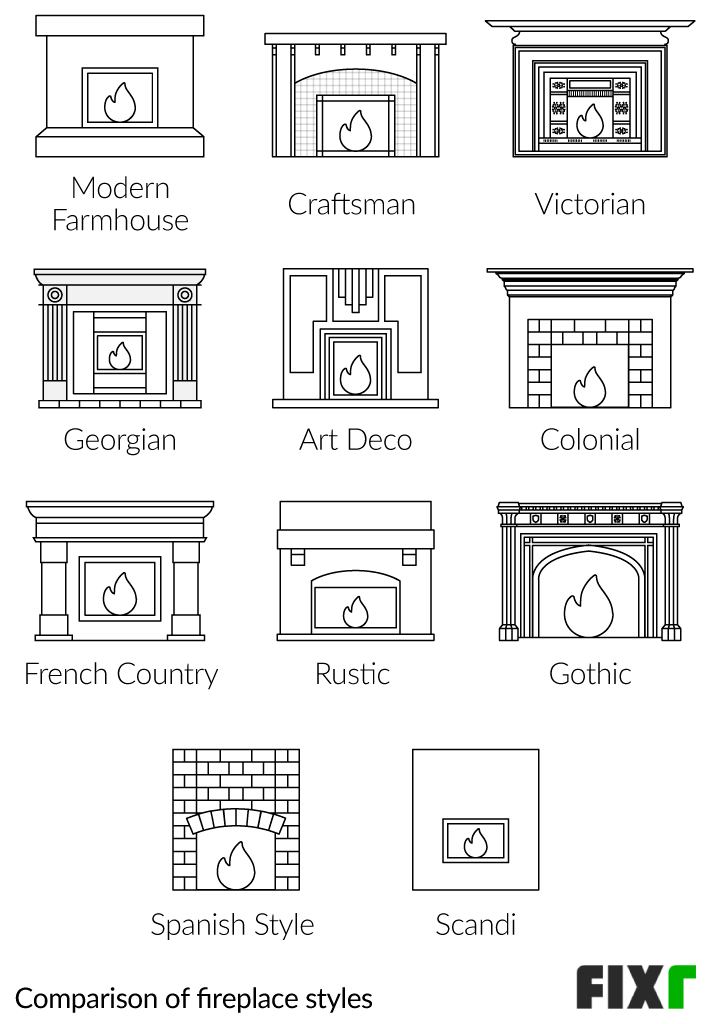
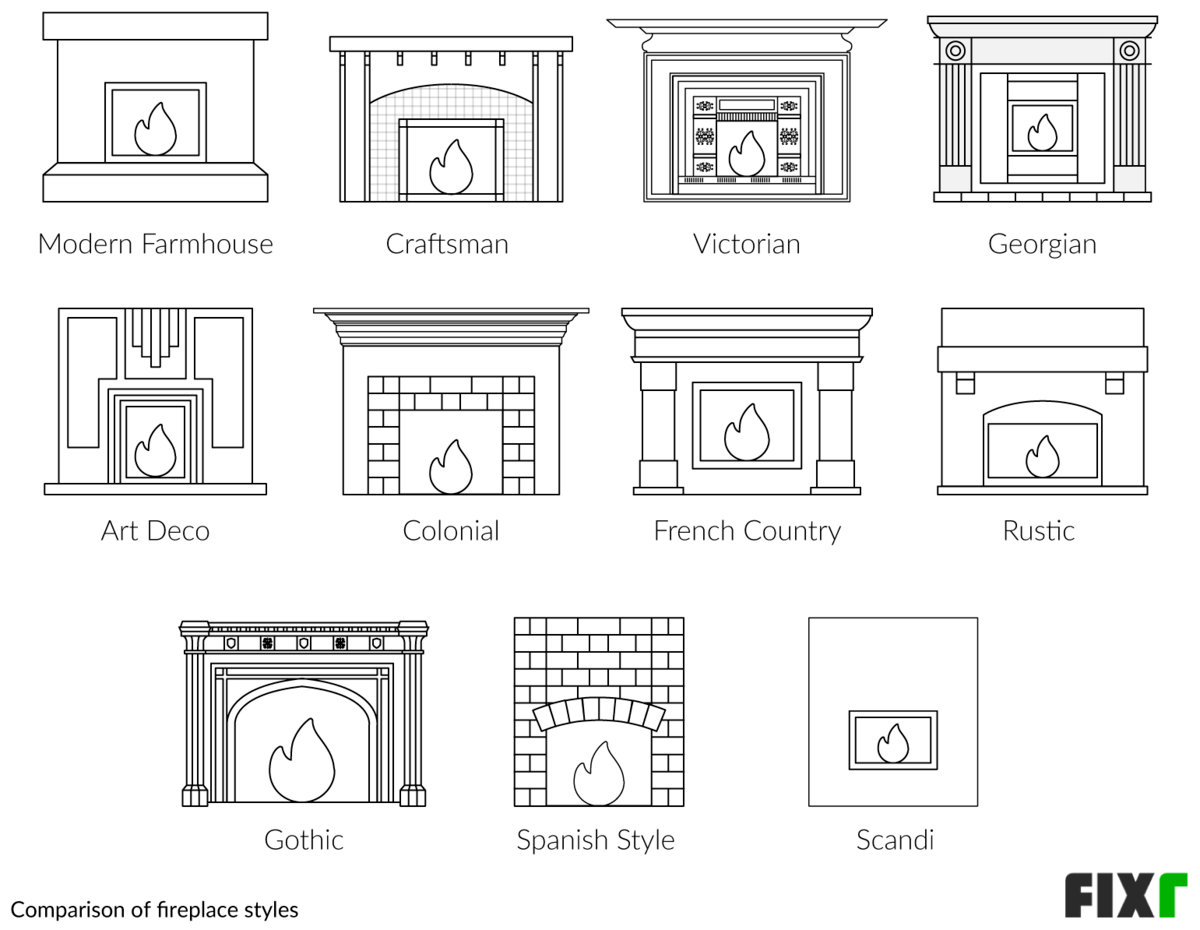
Modern Farmhouse
Modern farmhouse designs are basic and designed to blend into the room without drawing your eye and making the fireplace the focal point of the room. The surround material will be flat and simple, usually made of plaster, brick, or neutral-colored tile. It will not extend far from the wall and make the unit appear more like a part of the wall.
Craftsman
If you were to ask the average person what a fireplace looks like, they would likely draw you a picture that looks like a craftsman unit. The surround material of this type is most often made of wood with tile or stone on the inside, framing the fireplace. The surround material sticks further out so that the unit almost looks like a separate part from the wall. Your attention will be drawn to it when walking into the room. They typically feature a larger mantle and focus on simple lines in the design.
Victorian
Victorian surrounds are much more ornate looking than other designs. They most often feature a squared wooden surround with more decorative detailing, including scrolling. The insert in the surround is often designed to give an iron appearance and can feature detailed metalwork. In some cases, the opening of the fireplace has a tombstone design.
Georgian
A Georgian design draws inspiration from the Roman period and features the distinctive presence of columns on the sides. This style features more intricate designs and patterns on the surrounds and panels and works well in Georgian and traditional style homes. Wood is one of the most common mediums for surrounds in this style.
Art Deco
When it comes to art deco style, the sky’s the limit. Art deco is most known for its sharp lines but utilizes both symmetry and asymmetry throughout its patterns to make a look that appears to be a work of art. You can use any material for the surround with this style, but you will often find them in marble, tile, granite, or metal. This option is great for modern homes and rooms with a more eclectic design.
Colonial
Colonial style, also referred to as a traditional style, is a decor theme reminiscent of the colonial period. With a colonial style fireplace design, you will most likely see wood for the surround and a simple wood mantel. Colonial features strong rectangular lines and a simplistic pattern. The style is very simple and blends in with other decor themes and plenty of color schemes.
French Country
French country style fireplaces often include a white surround or other neutral color and are made of wood, stone, brick, or a combination. They typically feature a pronounced mantle that juts out significantly farther than the face of the fireplace and hangs over on the sides. The surround may feature more intricate cuts, but they are often made in straight lines.
Rustic
When you picture snuggling up by a fireplace in a cabin, you likely are picturing a wood-burning fireplace with a rustic surround. Most rustic units have a wood surround which can have a distressed finish or feature work from reclaimed pieces. In some cases, you may see stone rustic fireplaces. However, the stones in this type of decor vary in size and shape.
Gothic
For those who like over-the-top decor, a gothic fireplace is just what they need. They are ornate in their design and often resemble decor from Medieval periods. If made of wood, they feature intricate cuts and designs, though they are often made from marble, granite, or stone and tend to be dark in color. This type draws the eye, and the surround often overshadows the unit.
Spanish Style
Spanish-style fireplaces are easily identifiable by their stone, colored brick surrounds, and unique design patterns. Often the opening to these types of units is a semi-circle or rounded with a slight peak. Some feature different layers of colorful tile, stones, or bricks that form a distinctive pattern. Almost all of them feature multiple or bright colors in the surround.
Scandi
A Scandi design is considered minimal in decor types. Some surrounds are as simple as a rectangular box that juts out slightly from the fireplace. They tend to be in neutral colors and don’t draw the eye. They may even blend into the wall, making it hard to distinguish the surround from the wall. They are mostly rectangular and are often made of painted wood or light-colored marble or granite.
Smart Fireplace
Smart fireplaces cost from $425 to $4,500 and are typically electric or gas models. It operates in the same way that a regular electric or gas unit would, except that it can be linked to and controlled through smart home applications, such as Alexa or Google Home, or can be controlled directly from your smartphone. You can adjust the temperature, run time, and set programs all from the sound of your voice or through an app, even if you are away from home. If you forgot to turn your fireplace off before leaving, you can simply log into the app and shut it down.

Cost of Built-In Cabinets Around Fireplace
Homeowners spend between $550 and $570 a linear foot to have built-in cabinets installed around a fireplace. The total cost you spend for the project depends on the type of wood used, the number of cabinets, and their level of customization. The more detailed and the harder the wood used, the more expensive the project, with basic cabinets constructed from pine costing the least. Homeowners may choose to build cabinets around their fireplace for aesthetic reasons or to add more storage space.
Cost of Built-In Bookshelves Around Fireplace
Building bookshelves around your fireplace runs the same as building them somewhere else in your home. On average, homeowners pay between $300 and $1,200 a linear foot depending on the type of wood used and how large and wide the bookshelves are. Having bookshelves around the fireplace creates a traditional look in your home and is popular in libraries and studies.
Fireplace Types Comparison
One of the biggest decisions when choosing a fireplace for your home is deciding which type best suits your needs. Some things to consider include how much maintenance will be required, how long you can expect your unit to last, and whether or not it is energy-efficient or eco-friendly. Another important thing to consider is the safety of each type. Below you can compare and contrast each model.
Maintenance
The time and cost of maintenance are factors you will want to consider when deciding which type of fireplace is right for you. Gel, ethanol, and electric units are extremely low maintenance and require annual cleaning to run efficiently.
Gas fireplaces require a moderate amount of maintenance. The unit should be cleaned at least once a year, and an annual inspection of the system should be performed to ensure everything is still operating safely.
You can expect the most maintenance with a wood-burning fireplace. You will need to acquire wood as fuel. The fireplace and the chimney should be cleaned at least once a year and sometimes bi-annually if used as a regular source of heat. You need to make sure to regularly clean out the soot from the fireplace to prevent buildup.
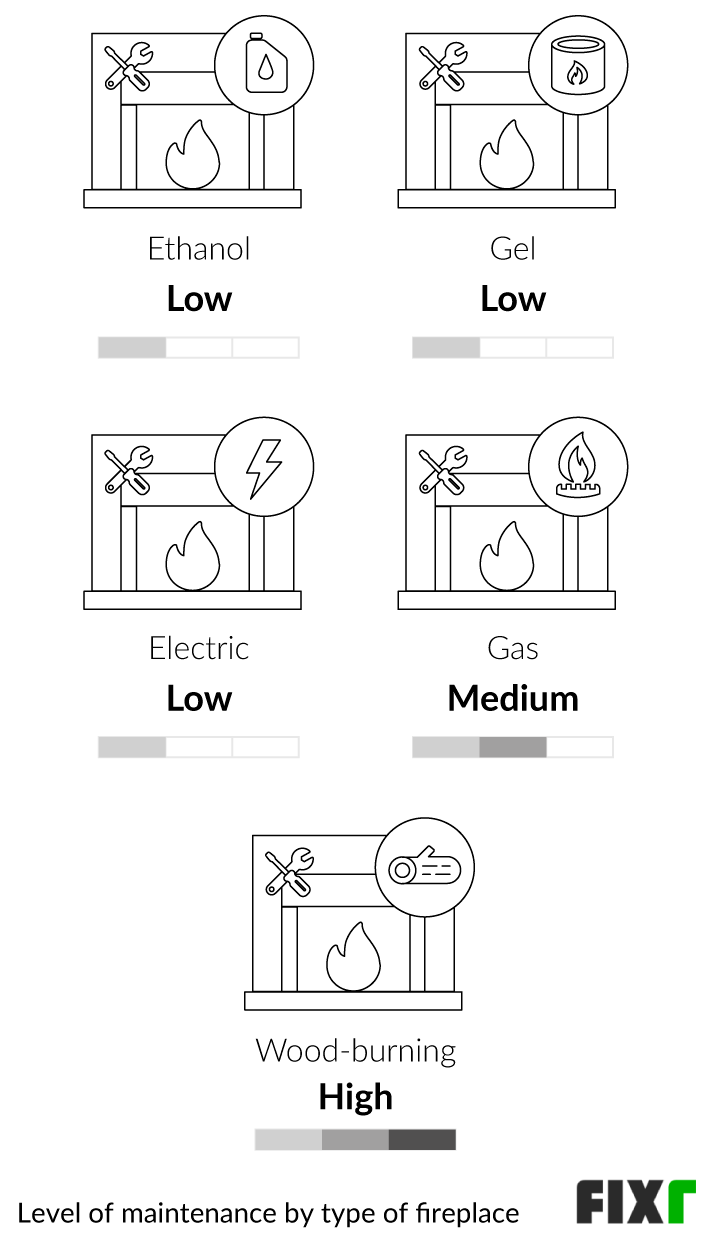

| Type | Maintenance Level |
| Ethanol | Low |
| Gel | Low |
| Electric | Low |
| Gas | Medium |
| Wood-Burning | High |
Durability
Fireplaces are an investment. The amount of the investment, in this case, tends to coincide with the length the investment lasts. Gel and ethanol units are the least costly to install and have the shortest lifespan. These, along with electric fireplaces, are considered appliances and tend to have the same longevity as other appliances. Electric models last a little longer, depending on the model and the type of installation.
Gas fireplaces last between 15 and 25 years. Wood-burning models last the longest, with an average of 20 to 30 years. Though in some cases, wood-burning units last a lot longer with proper repairs and maintenance.
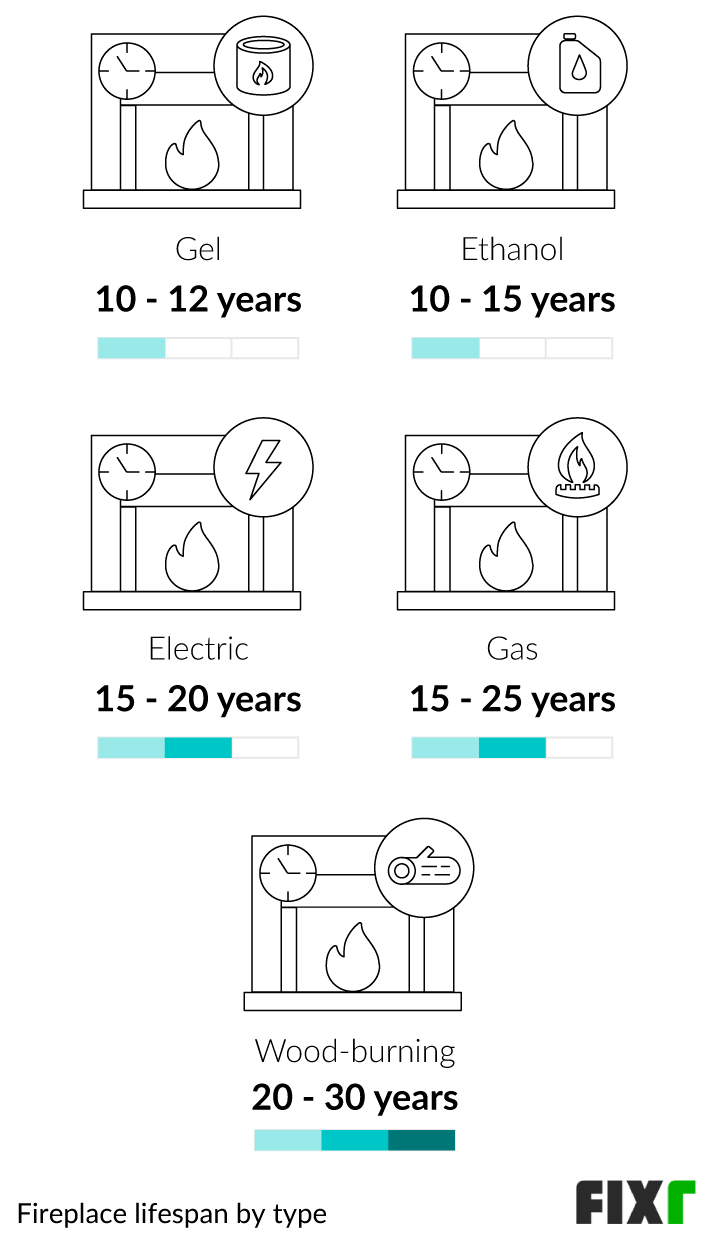

| Type | Lifespan |
| Gel | 10 - 12 years |
| Ethanol | 10 - 15 years |
| Electric | 15 - 20 years |
| Gas | 15 - 25 years |
| Wood-Burning | 20 - 30 years |
Energy Efficiency
Energy efficiency is another major concern when it comes to choosing the right type of fireplace. With rising energy costs and higher global concerns, maintaining efficiency is a top priority for many. When it comes to fireplaces, electric units boast the greatest energy efficiency. They require little electricity to operate. While they may not produce as much heat as a gas or wood fireplace, little heat is wasted.
Ethanol and gel fireplaces are also rated as good when it comes to energy efficiency. While they use fuel to operate, they both can last almost 12 hours on a small fuel container.
Gas fireplaces are considered fair in terms of energy efficiency. They use a lot of gas to operate, but little of the heat emitted is lost through the chimney. Wood-burning units are not very energy efficient, primarily because a large portion of the emitted heat is lost through the chimney to ensure that the fireplace is properly vented and safe.
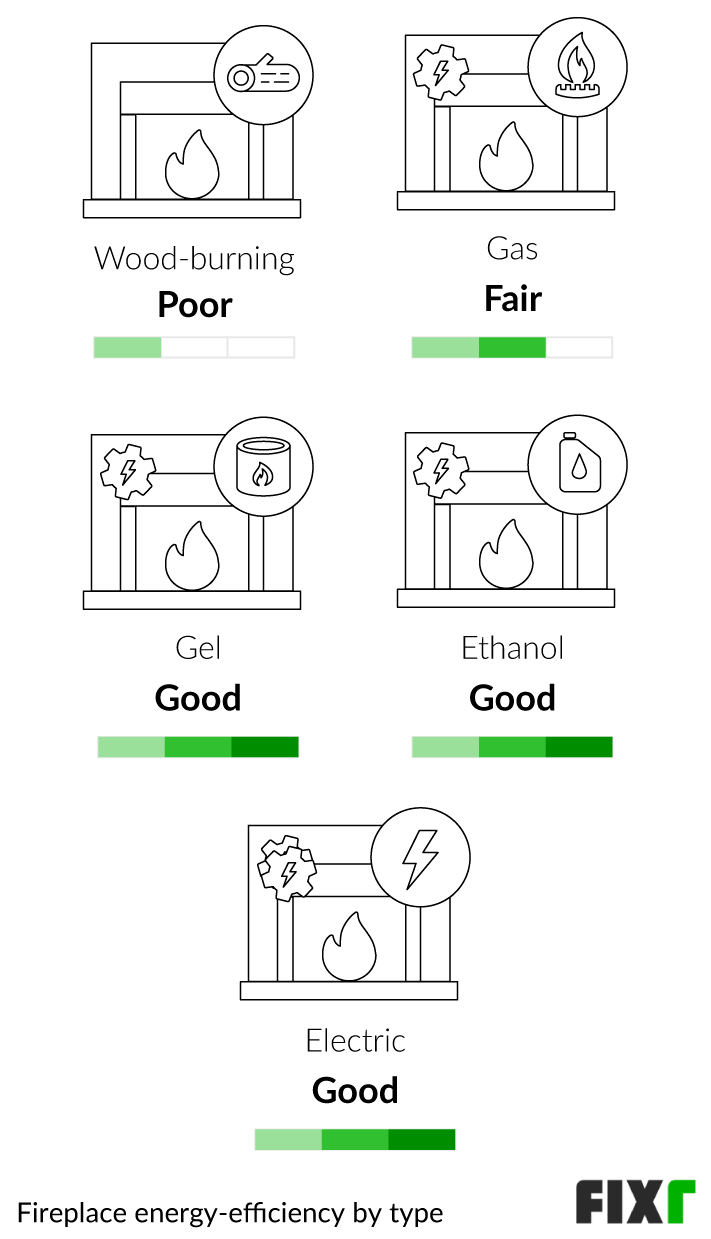

| Type | Energy Efficiency |
| Wood-Burning | Poor |
| Gas | Fair |
| Gel | Good |
| Ethanol | Good |
| Electric | Good |
Safety
Safety is a major concern for fireplaces and may be a deciding factor when a homeowner chooses a type. Ethanol, gel, and electric units are considered very safe as long as they are operated properly. They are enclosed and do not produce as much heat as gas or wood-burning fireplaces.
Gas units are considered a medium safety level. They are designed to be opened and reach higher temperatures, but once extinguished, there is no fire risk. There is a small risk of a gas leak if the gas lines in your home become damaged. However, these are often quickly and easily detectable with a carbon monoxide detector.
Wood-burning fireplaces are considered low risk in terms of safety for multiple reasons. They reach the hottest temperatures and tend to be open when in use. Another safety risk with wood-burning units is that even one live ember can reignite the fire and come out of the fireplace to start a fire in the home. Additionally, if not properly vented, a wood-burning fireplace can result in carbon monoxide leaking into your home.
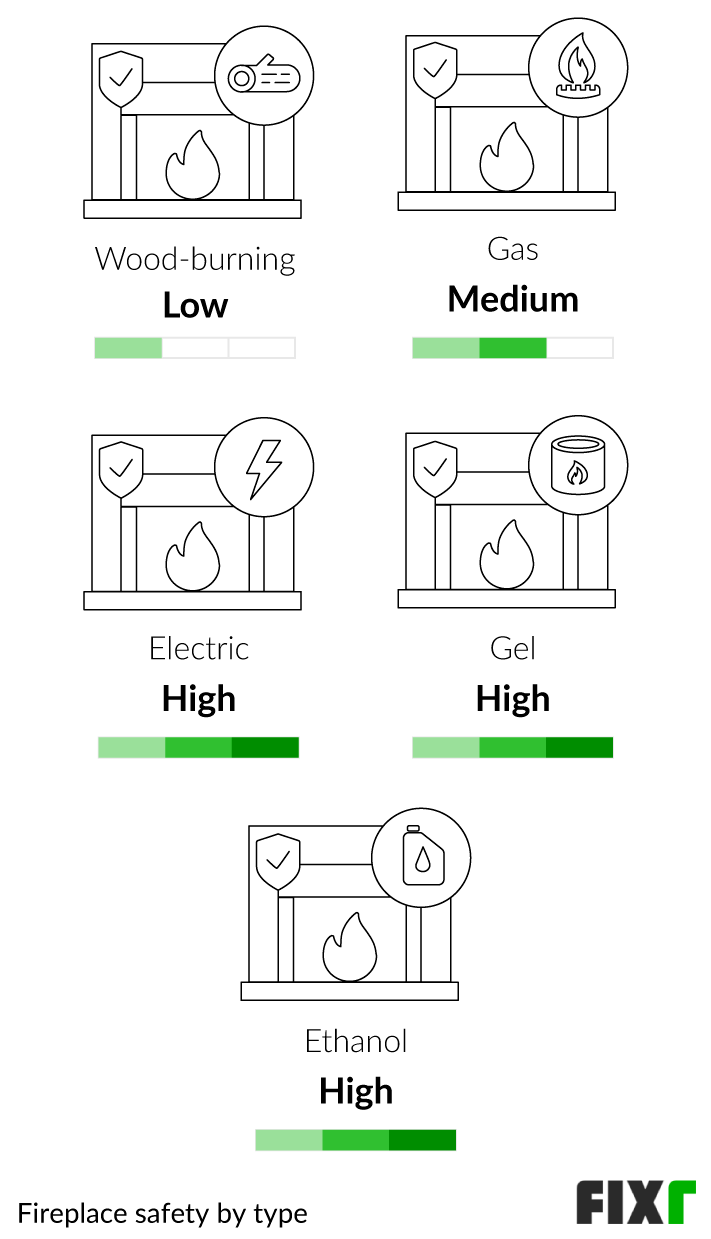

| Type | Safety |
| Wood-Burning | Low |
| Gas | Medium |
| Electric | High |
| Gel | High |
| Ethanol | High |
Environmental Impact
When it comes to eco-friendliness, the main concern is whether or not they give off emissions. Secondary to that is whether or not it requires fuel for use. Wood-burning fireplaces are the least eco-friendly. The particles emitted when the wood burns can be hazardous in large quantities. In some localities, wood-burning units are banned for that reason.
Gas fireplaces have a medium environmental impact. According to the EPA, they release 99% fewer particles than wood-burning units, but they require the use of natural gas.
Gel and ethanol fireplaces only have a low to moderate environmental impact. They do not produce emissions but require a fuel source to operate. The type with the lowest environmental impact is an electric unit. This type has no emissions and requires no fuel source.


| Type | Environmental Impact |
| Electric | Low |
| Ethanol | Low-Medium |
| Gel | Low-Medium |
| Gas | Medium |
| Wood-Burning | High |
Pros and Cons
As with almost any type of home addition, there are pros and cons to having a fireplace installed. One of the main reasons that homeowners install a fireplace is to have an additional heat source. They are great for large rooms that can take a while to heat up. With most fuel types, using them lowers the overall energy cost in your home. Another popular benefit is the ambiance they create. They add to the decor and create a relaxing and inviting atmosphere. They also add value to your home.
Even though fireplaces are great for almost any home, there are some drawbacks. One is the extra cleaning it requires. If you have a wood-burning unit, you may have extra dust and dirt around it. Fireplaces can be safety hazards if not cared for properly or left unattended when the flame is open. For those with a wood-burning unit, another drawback is having to find storage for your woodpile.

Should a TV Go Above a Fireplace?
It is never advisable to have a television above a fireplace. In general, electronics and heat never mix. The fireplace makes the area above it much hotter than the room, which can cause the electronics to malfunction and shorten their lifespan. If the only place to put your television is above the fireplace, it is best to install a mantel that extends out farther because it deflects some of the heat from rising to the television.
On top of the potential damage to your television, the area above your unit will likely not be ideal in terms of size and space. When you mount a television above a fireplace, you will be limited to a certain amount of space. Additionally, your television will likely be higher than the best viewing angle.
Wood-Burning Stove vs Fireplace
Wood-burning fireplaces are more costly to install than wood-burning stoves costing an average of $8,000 to $22,000 versus $3,100 to $5,550. Choosing between the two often comes down to a matter of preference. A few things must be considered. Wood-burning stoves are the more efficient option when using them for a source of heat. They boast about 80% efficiency, while wood-burning fireplaces are only around 25%. This is mainly because a wood-burning fireplace is open while it is operating.
Another thing to consider is the emissions produced by both. While both produce some carbon monoxide, most of the emissions on a wood-burning stove vent out of the chimney. On the other hand, there might be slightly more carbon monoxide getting into the home with a fireplace that tends to be open. You can reduce the emissions into your home from the fireplace by using a glass door. But if you are looking for ambiance, nothing beats the crackle and glow of a wood-burning fireplace.
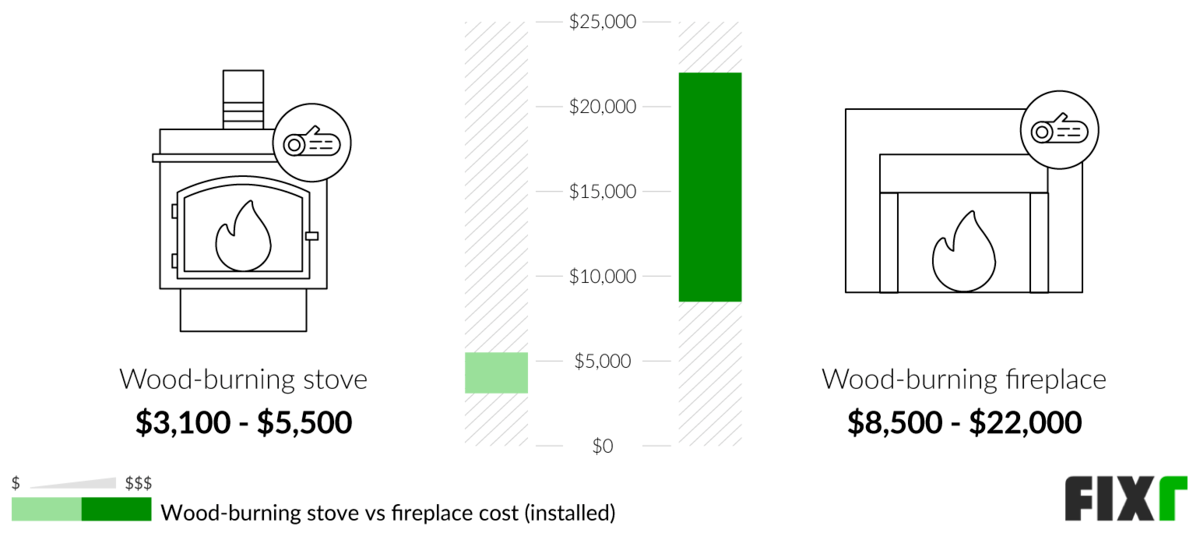

| Type | Average Cost Range (Installed) |
| Wood-Burning Stove | $3,100 - $5,500 |
| Wood-Burning Fireplace | $8,500 - $22,000 |
Enhancement and Improvement Costs
Fireplace Cleaning
Having a fireplace cleaned runs from $95 to $150. If you need your chimney cleaned, you can expect $100 to $300 to be added on top of that cost. On average, you should have your unit cleaned at least once a year. You may want to have more frequent cleanings if you use your unit often. Keeping it clean reduces the dust in your home and keeps everything functioning properly. It is a job best left to the professionals as it can be quite messy, and caution should be used to prevent safety hazards.
Whitewash Brick Fireplace
If you want to whitewash your fireplace, you can expect to pay between $2 and $4 per sq.ft. Whitewashing can be used to create a more rustic look, lighten up your unit’s existing exterior, or prep the area to paint it another color.
Paint a Fireplace
You can expect to pay anywhere between $2 and $5 a sq.ft. to have your fireplace painted. The cost depends on the material it is made of and the number of coats of paint needed to achieve the desired color. Plaster and wood surrounds will likely be the cheapest to paint. Surrounds with stone or brick cost more because they require more paint and labor to complete.
Automatic Thermostat
If you are interested in an automatic thermostat for your fireplace, you can get one for $50 to $200. These thermostats are designed to be programmable and allow you to set the room at the desired temperature. If the temperature in the room changes, the fireplace makes the necessary adjustments to ensure that the room stays at a comfortable temperature. Automatic thermostats are designed to work with all types of fireplaces except wood-burning units.
Lava Rocks for Gas Fireplace
If you want to add lava rocks to your fireplace, you can expect them to cost $25 to $50. They are made of either heat-resistant ceramic or tempered glass, which sits in the burner pan and allows you to create a unique look. You can choose from a wide range of sizes, shapes, and various colors to customize your look.
Outdoor Pavilion with Fireplace
Suppose you want to create a unique and welcoming outdoor area. You can build an outdoor pavilion with a fireplace for $4,000 to $40,000, depending on flooring and roofing materials and the size of the pavilion. These areas are ideal for rest and relaxation or as another place for entertainment protected from the elements. Pavilions range from simple enclosures to complete living spaces.
Fireplace Blower
Fireplace blowers cost between $150 and $300. They are an accessory that can be used with your fireplace and are designed to draw cool air into your fire. This helps fuel the fire and facilitates the pushing of the hot air out into the room. A blower circulates the hot air from your unit and heats the room quicker. It can also help with energy efficiency in your home because it allows your fireplace to take over some of the heating functions and allows you to lower your thermostat.
Not all fireplaces are designed to accept fireplace blowers. They only work with gas and wood-burning units because they have venting units to draw in the air. For a fireplace blower to work with your gas or wood-burning unit, it must be a model referred to as a circulating style that has vented or louvered upper panels.
Additional Considerations and Costs
- Restrictions. Wood-burning fireplaces are not permitted in all localities because of the emissions and particles that are released. You should always check with your city and state regarding any restrictions before having one installed.
- Ambiance. Some homeowners prefer a more rustic and natural experience. In this case, a wood-burning fireplace is likely the best option. With it, you get the smell of the burning wood and the crackling, creating the ambiance some homeowners desire.
- Safety. Wood-burning fireplaces come with some safety risks, making them less than ideal in certain homes and households. You should never leave a wood-burning fire unattended, even if you think it has gone out. Even a slight ember can restart it. The glass on a wood-burning unit can be dangerous. It can reach temperatures as high as 400 degrees and take at least 45 minutes to cool down. Protective screens should be used when young children are around.
- Permits. If you have a wall-mounted or freestanding electric, gel, or ethanol fireplace, you won’t need a permit to install it. But if you choose to install a gas or wood-burning unit or add a chimney, a permit will be required. To obtain a permit, you need to have a plan that shows the fireplace and chimney placement in relation to doors, windows, and the walls of the home.
- Ashes. If you have a lawn or garden that needs lime and potassium, spread wood ashes evenly over it to improve the soil. It is important not to overdo it. Generally, you will want to use about 5 to 10 lbs. for a 500 to 800 sq.ft. area.
- Repairs. Fireplace repairs range from $200 to $5,000, depending on the type of repairs and type of unit. You should always have a professional perform your unit repairs as improper repairs can lead to safety issues, especially with wood- or gas-burning units.
FAQs
- How much does it cost to build a fireplace and chimney?
The average cost to install a fireplace and chimney runs from $10,000 to $40,000. The cost depends on the size of the fireplace and the number of stories.
- How much does it cost to build an outdoor fireplace?
Outdoor fireplaces cost between $4,000 and $8,000 to install, depending on the size, fuel source, and customization.
- Are wood-burning fireplaces permitted in your area?
Though it is always best to check with city and county ordinances in your area, in general, wood-burning fireplaces are permitted as long as they meet the EPA limit on the number of particles emitted through the chimney.
- Does a fireplace add value to a home?
When you add a fireplace to your home, you increase the value between 5% and 9%. In most cases, the added value will recoup 100% of the costs for the install. Additionally, fireplaces can be an attractive selling point.
- Are gas fireplaces good for heating a home?
Gas fireplaces can be very efficient for heating a small area. For small cabins, they can sometimes heat the entire space. However, if you have a home with several rooms, you will typically require another source of heat as well.
- Can you plug an electric fireplace into a regular outlet?
Most electric fireplaces work when plugged into a regular 110V outlet. With a built-in electric fireplace, you have the option of hardwiring it to a 110V or 220V circuit.
